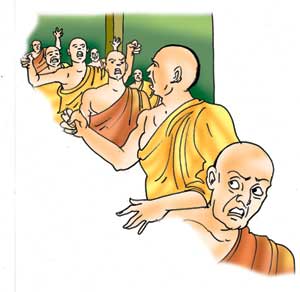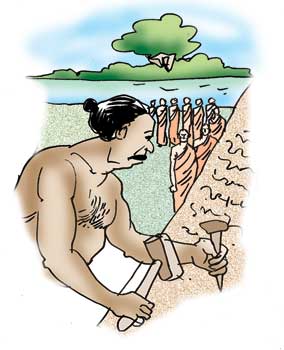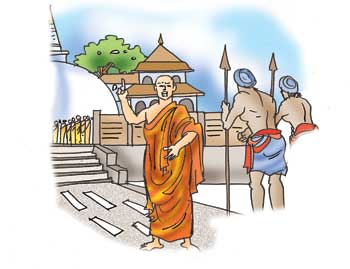
Council of monks~This article is part of a continuing series on the ‘Mahavamsa,’ the recorded chronicle of Sri Lankan history~
2. There was one big commotion in the assembly hall. Some came up with suggestions and started to blame the chief priests of Mahavihara. But King Parakrambahu accepted the proposals, put forward by the monks of Mahavihara. The quarrelsome bikkhus then got angry with even the king. But the king was not shaken. He stood by his decision. Some of the monks who got angry, fled the country.
4. It was difficult to create some sort of unity among these monks. In the midst of these monks were individuals who had different opinions. There were monks who did not tolerate each other. Realising the gravity of the problem, Venerable Kashyapa undertook the task. There was a section of monks who rose up even against the leader, Venerable Kashyapa. They even threatened him. But Venerable Kashyapa had the necessary courage to handle this difficult situation. 5. In all three sects there were a few monks who had donned the yellow robe, just as a means of survival. They could not even deliver a sermon properly as they had not learnt the Dhamma. They were shrewd enough to deceive the lay crowd and survive. Venerable Kashyapa got these monks derobed. The rest who were respectful and disciplined were given proper instructions. They accepted the words of Venerable Kashyapa and joined him. They forgot the petty differences they had and decided to unite and work for the progress of the 'Sasana' – the Order of Monks.
7. This council proved to be a success. The king decided to stop the decline of Vinaya among the monks. He sought the advice of the learned monks once more and got them to prepare a Code of Laws for the monks. These rules were written down on a slate of stone. To date, this inscription could be seen at Polonnaruwa. It is at 'Galvihara.' 8. Meanwhile, the soldiers who were in South India erected a temple in Sinhapura. It was named 'Kusinara.' However, the description of the war in South India, has come to an abrupt end in our chronicles. Our chronicles record only the victories of the Sinhala soldiers. They try to depict Prince Kulasekera as a weak ruler. |
|| Front
Page | News | Editorial | Columns | Sports | Plus | Financial
Times | International | Mirror | TV
Times | Funday
Times || |
| |
Reproduction of articles permitted when used without any alterations to contents and the source. |
© Copyright
2007 | Wijeya
Newspapers Ltd.Colombo. Sri Lanka. All Rights Reserved. |
 1. The monks who participated in the council were from Ruhuna, Sabaragamuwa and Anuradhapura. They represented the three Nikayas and were the leading monks of the day. The king provided all the comforts to these monks. The council was convened and the proceedings commenced. Venerable Kashyapa was to preside. The first emphasis was on unity and it was suggested to follow one code of ethics. Several monks opposed this.
1. The monks who participated in the council were from Ruhuna, Sabaragamuwa and Anuradhapura. They represented the three Nikayas and were the leading monks of the day. The king provided all the comforts to these monks. The council was convened and the proceedings commenced. Venerable Kashyapa was to preside. The first emphasis was on unity and it was suggested to follow one code of ethics. Several monks opposed this. 3. Some other monks boycotted the meeting, while others went to the extent of giving up robes. None of these things could upset the king. Venerable Kashyapa, the erudite priest who was well-versed in the Vinaya kept to his principles. King Parakramabahu too supported his decision. There arose another problem then. That was the difficult task of uniting the rest of the monks. As the three sects were in three different places, they had to be brought to one place.
3. Some other monks boycotted the meeting, while others went to the extent of giving up robes. None of these things could upset the king. Venerable Kashyapa, the erudite priest who was well-versed in the Vinaya kept to his principles. King Parakramabahu too supported his decision. There arose another problem then. That was the difficult task of uniting the rest of the monks. As the three sects were in three different places, they had to be brought to one place. 6. The 'Rajavaliya' refers to Venerable Kashyaopa as Dimbulagala Kashyapa. This however was a period when the 'Vinaya' – the discipline of the monks, had to be re-established. So there had to be a Council on Vinaya too. By this time, 'Upasampada' – the 'Higher Ordination' – had not been held. That is why King Parakramabahu had to take all the trouble to reorganize the Vinaya.
6. The 'Rajavaliya' refers to Venerable Kashyaopa as Dimbulagala Kashyapa. This however was a period when the 'Vinaya' – the discipline of the monks, had to be re-established. So there had to be a Council on Vinaya too. By this time, 'Upasampada' – the 'Higher Ordination' – had not been held. That is why King Parakramabahu had to take all the trouble to reorganize the Vinaya.